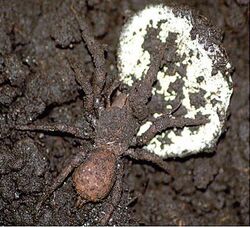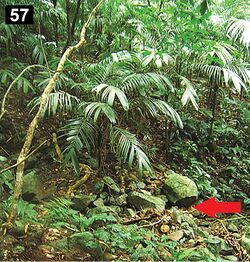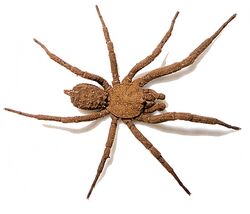Biology:Paratropis tuxtlensis
| Paratropis tuxtlensis | |
|---|---|

| |
| Female with egg sac | |
| Scientific classification Error creating thumbnail: Unable to save thumbnail to destination
| |
| Domain: | Eukaryota |
| Kingdom: | Animalia |
| Phylum: | Arthropoda |
| Subphylum: | Chelicerata |
| Class: | Arachnida |
| Order: | Araneae |
| Infraorder: | Mygalomorphae |
| Family: | Paratropididae |
| Genus: | Paratropis |
| Species: | P. tuxtlensis
|
| Binomial name | |
| Paratropis tuxtlensis Valdez-Mondragón, Mendoza & Francke, 2014[1]
| |
Paratropis tuxtlensis is a species of spider in the family Paratropididae. Discovered in 2014 by a group of researchers from the National Autonomous University of Mexico,[2] the species is only known to occur in the Volcán San Martin Biosphere Reserve in Veracruz, Mexico.[3]
Description
The holotype male measured 8.20 millimeters in length, and the paratype female measured 12.90 millimeters. When cleansed of soil (see Behavior, below) the body is reddish, with orange coloration on its chelicerae, sternum, endites, and labium. Legs are olive colored, and spinnerets are yellow.[4]
Paratropis tuxtlensis is distinguished from Paratropis papilligera, the only other species of Paratropis where the male is known, by its conical as opposed to cylindrical tibia and by the number of teeth in the cheliceral furrows: P. tuxtlensis has a total of 20 while P. papilligera has 24.[4]
The species has an orbiculate carapace and legs covered in barbed and clubbed setae.[4]
Range and habitat
Paratropis tuxtlensis is the first member of the family Paratropididae to be found in North America.[2] It is native to tropical rainforest in Veracruz, Mexico. The first recorded specimens were discovered under rocks at an elevation of 1,039 metres (3,409 ft); two more individuals were collected nearby at a lower elevation.[4]
Etymology
The species name P. tuxtlensis is derived from Los Tuxtlas, Veracruz, the only place to date where it has been found.[5]
Behavior
Paratropis tuxtlensis excretes a sticky substance from glandular pores in its exoskeleton, which helps particles of soil adhere to its body. This most likely serves as a form of camouflage to conceal it from both predators and prey.[4] When exposed, the spider remains completely motionless in order to avoid detection.[4][6]
References
- ↑ Norman I. Platnick (June 16, 2014). "FAM. PARATROPIDIDAE Simon, 1889". http://research.amnh.org/iz/spiders/catalog/PARATROPIDIDAE.html.
- ↑ 2.0 2.1 "A new spider species with a dirt armour has been discovered". 24 June 2014. http://www.sciencealert.com.au/news/20142406-25726.html.
- ↑ "New Species of Spider with Strange Camouflage Discovered in Mexico". Jun 24, 2014. http://www.sci-news.com/biology/science-new-species-spider-strange-camouflage-mexico-02015.html.
- ↑ 4.0 4.1 4.2 4.3 4.4 4.5 Valdez-Mondragón, Alejandro; Mendoza, Jorge I.; Francke, Oscar F. (16 June 2014). "First record of the mygalomorph spider family Paratropididae (Arachnida, Araneae) in North America with the description of a new species of Paratropis Simon from Mexico, and with new ultramorphological data for the family". ZooKeys (Pensoft Publishers) (416): 1–21. doi:10.3897/zookeys.416.7253. PMID 25061343. PMC 4109506. https://www.pensoft.net/J_FILES/1/articles/7253/7253-G-1-layout.html. Retrieved 26 June 2014.
- ↑ "A new spider species from Mexico uses soil particles for camouflage". Jun 23, 2014. http://phys.org/news/2014-06-spider-species-mexico-soil-particles.html.
- ↑ "Spider Discovered in Mexico Uses Encrusted Soil Particles for Camouflage". June 23, 2014. http://www.sciencespacerobots.com/spider-discovered-in-mexico-uses-encrusted-soil-particles-for-62320141.
External links
Wikidata ☰ Q17280163 entry
 |



